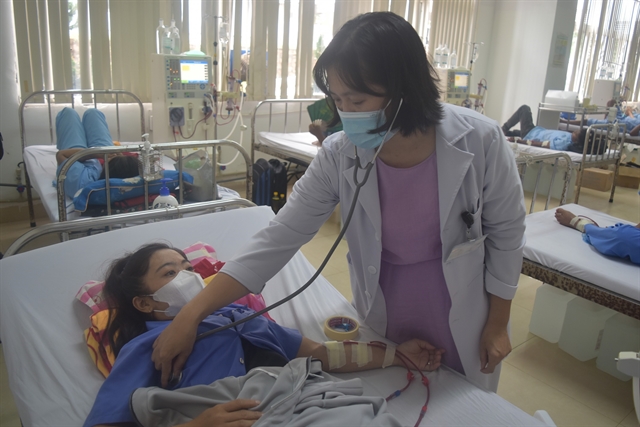 Society
Society

 |
| A 28-year-old patient receives treatment for kidney function decline in Đắk Lắk Province. — VNA/VNS Photo Nguyên Dung |
HÀ NỘI — Kidney diseases are becoming more common among younger people, with many patients only aware of their conditions at the stage when emergency dialysis is required.
Dr. Nguyễn Bách, head of the Department of Nephrology and Hemodialysis in HCM City’s Thống Nhất Hospital, revealed that according to screening statistics, about 8.75 per cent of the national population is at risk for kidney diseases.
Statistics also show that six to eight out of 100 people have kidney diseases with no symptoms.
While most patients with end-stage renal disease (ESRD) are typically 60-65 years old, Việt Nam is seeing a shift to younger age groups.
In most cases for patients aged 60-65, the cause of kidney failure mainly stems from diabetes or hypertension. However, among younger people, it is typically due to glomerular diseases, said the doctor.
Glomerular diseases affect very small blood vessels in the kidneys that help remove waste products from the blood.
“Most glomerular diseases show no symptoms, and coupled with the fact that many people don’t have the habit of going to regular health check-ups, a lot of patients only find out about their kidney conditions when they already require emergency dialysis,” said Dr. Bách.
Symptoms emerged when the disease had already progressed to a severe stage, noted the doctor, adding that Thống Nhất Hospital was seeing an overwhelming number of patients with end-stage kidney disease requiring dialysis or transplants.
Vương Thúy Anh, a resident of HCM City’s District 12, told Sức khỏe & Đời sống (Health & Life) newspaper: “Last month, my husband experienced swelling in his hands and feet and frequent nighttime urination with dark urine. When he went for a check-up, he was diagnosed with stage three kidney disease.”
Meanwhile, the Central Highlands province of Đắk Lắk has counted about 550 cases of chronic kidney diseases, with many of the patients under the age of 60.
The region’s general hospital is tending to about 200 patients requiring dialysis, about 17.5 per cent of them in the 18-35 age group. The youngest is only 16 years old.
Dr. Hoàng Thị Thủy Tiên from the Department of Intensive Care and Toxicology at the Central Highlands’ general hospital said that the risk of kidney diseases among young people had increased from 6 per cent to 15 per cent.
This rise could be attributed to increasing rates of diabetes and hypertension among younger age groups, in addition to the lack of physical exercise and overconsumption of high-fat and high-protein food.
Common unhealthy habits such as staying up late, consuming alcohol and smoking also lead to a higher risk of metabolic dysfunctions, which in turn increase the likelihood of kidney diseases.
Việt Nam currently has about 400 health facilities offering dialysis or blood filtration services for about 30,000 patients with ESRD each year. However, this represents only about 30 per cent of the total demand for dialysis in the country.
Nguyễn Hữu Tú, general secretary of the Việt Nam Young Physicians Association, said that early detection and treatment of chronic kidney disease would help slow declines in kidney function.
Renal replacement therapy could bring long-term economic benefits and reduce the burden on the healthcare system, he added.
According to Dr. Bách, while kidney diseases are non-infectious, they can be dangerous, especially when clinical symptoms have emerged. Therefore, regular screenings are recommended for early detection and intervention.
Global statistics revealed that chronic kidney diseases are ranked 12th among the most common causes of death, accounting for 4.6 per cent.
Việt Nam estimated that over 8.7 million adults in the country, or 12.8 per cent of the national population, are affected by chronic kidney diseases. — VNS




